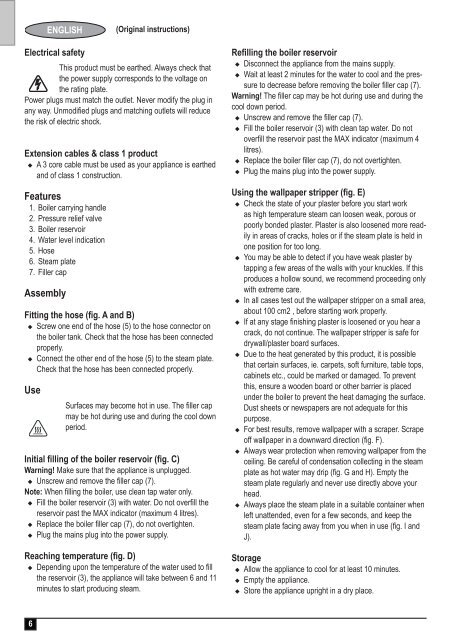BlackandDecker Decolleuse Papier/pe- Kx3300 - Type 1-2 - Instruction Manual (Anglaise)
BlackandDecker Decolleuse Papier/pe- Kx3300 - Type 1-2 - Instruction Manual (Anglaise)
BlackandDecker Decolleuse Papier/pe- Kx3300 - Type 1-2 - Instruction Manual (Anglaise)
You also want an ePaper? Increase the reach of your titles
YUMPU automatically turns print PDFs into web optimized ePapers that Google loves.
ENGLISH<br />
(Original instructions)<br />
Electrical safety<br />
This product must be earthed. Always check that<br />
the power supply corresponds to the voltage on<br />
the rating plate.<br />
Power plugs must match the outlet. Never modify the plug in<br />
any way. Unmodified plugs and matching outlets will reduce<br />
the risk of electric shock.<br />
Extension cables & class 1 product<br />
u A 3 core cable must be used as your appliance is earthed<br />
and of class 1 construction.<br />
Features<br />
1. Boiler carrying handle<br />
2. Pressure relief valve<br />
3. Boiler reservoir<br />
4. Water level indication<br />
5. Hose<br />
6. Steam plate<br />
7. Filler cap<br />
Assembly<br />
Fitting the hose (fig. A and B)<br />
u Screw one end of the hose (5) to the hose connector on<br />
the boiler tank. Check that the hose has been connected<br />
pro<strong>pe</strong>rly.<br />
u Connect the other end of the hose (5) to the steam plate.<br />
Check that the hose has been connected pro<strong>pe</strong>rly.<br />
Use<br />
Surfaces may become hot in use. The filler cap<br />
may be hot during use and during the cool down<br />
<strong>pe</strong>riod.<br />
Initial filling of the boiler reservoir (fig. C)<br />
Warning! Make sure that the appliance is unplugged.<br />
u Unscrew and remove the filler cap (7).<br />
Note: When filling the boiler, use clean tap water only.<br />
u Fill the boiler reservoir (3) with water. Do not overfill the<br />
reservoir past the MAX indicator (maximum 4 litres).<br />
u Replace the boiler filler cap (7), do not overtighten.<br />
u Plug the mains plug into the power supply.<br />
Reaching tem<strong>pe</strong>rature (fig. D)<br />
u De<strong>pe</strong>nding upon the tem<strong>pe</strong>rature of the water used to fill<br />
the reservoir (3), the appliance will take between 6 and 11<br />
minutes to start producing steam.<br />
Refilling the boiler reservoir<br />
u Disconnect the appliance from the mains supply.<br />
u Wait at least 2 minutes for the water to cool and the pressure<br />
to decrease before removing the boiler filler cap (7).<br />
Warning! The filler cap may be hot during use and during the<br />
cool down <strong>pe</strong>riod.<br />
u Unscrew and remove the filler cap (7).<br />
u Fill the boiler reservoir (3) with clean tap water. Do not<br />
overfill the reservoir past the MAX indicator (maximum 4<br />
litres).<br />
u Replace the boiler filler cap (7), do not overtighten.<br />
u Plug the mains plug into the power supply.<br />
Using the wallpa<strong>pe</strong>r strip<strong>pe</strong>r (fig. E)<br />
u Check the state of your plaster before you start work<br />
as high tem<strong>pe</strong>rature steam can loosen weak, porous or<br />
poorly bonded plaster. Plaster is also loosened more readily<br />
in areas of cracks, holes or if the steam plate is held in<br />
one position for too long.<br />
u You may be able to detect if you have weak plaster by<br />
tapping a few areas of the walls with your knuckles. If this<br />
produces a hollow sound, we recommend proceeding only<br />
with extreme care.<br />
u In all cases test out the wallpa<strong>pe</strong>r strip<strong>pe</strong>r on a small area,<br />
about 100 cm2 , before starting work pro<strong>pe</strong>rly.<br />
u If at any stage finishing plaster is loosened or you hear a<br />
crack, do not continue. The wallpa<strong>pe</strong>r strip<strong>pe</strong>r is safe for<br />
drywall/plaster board surfaces.<br />
u Due to the heat generated by this product, it is possible<br />
that certain surfaces, ie. car<strong>pe</strong>ts, soft furniture, table tops,<br />
cabinets etc., could be marked or damaged. To prevent<br />
this, ensure a wooden board or other barrier is placed<br />
under the boiler to prevent the heat damaging the surface.<br />
Dust sheets or newspa<strong>pe</strong>rs are not adequate for this<br />
purpose.<br />
u For best results, remove wallpa<strong>pe</strong>r with a scra<strong>pe</strong>r. Scra<strong>pe</strong><br />
off wallpa<strong>pe</strong>r in a downward direction (fig. F).<br />
u Always wear protection when removing wallpa<strong>pe</strong>r from the<br />
ceiling. Be careful of condensation collecting in the steam<br />
plate as hot water may drip (fig. G and H). Empty the<br />
steam plate regularly and never use directly above your<br />
head.<br />
u Always place the steam plate in a suitable container when<br />
left unattended, even for a few seconds, and keep the<br />
steam plate facing away from you when in use (fig. I and<br />
J).<br />
Storage<br />
u Allow the appliance to cool for at least 10 minutes.<br />
u Empty the appliance.<br />
u Store the appliance upright in a dry place.<br />
6
















